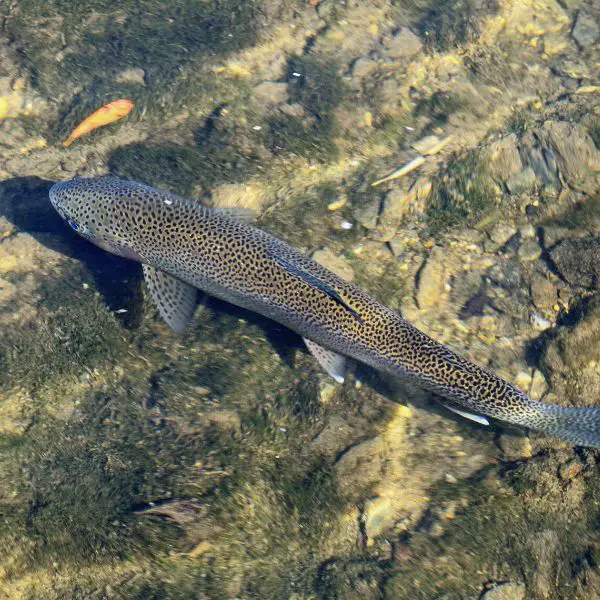I have recently been hearing reports from the Rocky Mountain area, that large brown trout are showing up in streams that only hold rainbows and cutthroat trout this time of year. Meanwhile, other reports, are saying that fewer trout are being caught lower down the river system. Productive pools and runs now seem barren.
For obvious reasons, I am not going to share the names of the streams, the last thing I want is to encourage hoards of people to descend upon some of the more delicate headwater tributaries out west.
With that said, brown trout heading to the headwaters in the middle of summer is certainly out of the norm. They do not usually start their migration runs until well into October.
So what could be the cause of this unseasonable movement? I will discuss the possible reasons why.
Brown trout hate warm water (are high temperatures to blame?)
When water temperature reaches the high 60-degree range, brown trout often migrate upstream in search of cooler water. Several research projects telemetry tracked brown trout movements throughout the year, and the majority found that virtually all brown trout have migrated out of their usual range by the time water temperatures have reached 70f (1,2).
Results did differ in one study (3), that followed brown trout in Chattooga river. In this case, the trout did not migrate to the cooler water despite water temperatures surpassing the stress point.
If you have been following the news lately, parts of the northwest have been experiencing heatwave like conditions over the previous few weeks. Are the hot days, and muggy nights enough to warm the normally cool summertime refuges enough to encourage the brown trout to relocate upstream?
Will, prior to writing this article. I personally checked the water temperatures and on average, many of the rivers are 1 – 1.5 c (1.8-2.5f) warmer than average for this time of the year.
With august being among the warmest months for river temperatures it might just be enough to encourage trout to head further upstream. Some of the brown trout rivers have certainly been inching toward the high 60s which will see brown move upstream in their search for colder water.
This, in my opinion, is the most likely reason why brown trout are showing up in small headwater streams where they do not normally occur. Conditions lower down are getting too warm for them.
Maybe, they are heading to spawn early?
I feel like, I have to take a serious look at whether something might have triggered the brown trout to spawn early. After all, many species sometimes breed outside of their usual season, such as a family of ducklings I saw the first week of December. Nature can be out of tune at times.
In the Rockies, brown trout typically spawn from the start of October and it goes into December (4,5),. So that will mean the sighted trout have arrived the best part of two months early when the temperatures in the spawning streams are still too high. (For spawning, not for living)
The trigger which makes a brown trout want to spawn is usually a decrease in water temperature towards 47c and an increase in water levels to assist in upstream migration. It is safe to say, most of the lower sections of mountain rivers are still around or above 60f, and few of the monitored headwaters are dropping below 47f even at night.
I feel it is safe to assume that the brown trout are not in the steams early to spawn.
Any other reasons?
There are a couple more variables, that can see brown trout moving upstream out of season.
Brown trout that have seen a lot of disturbance, such as extreme angling pressure, heavy machinery, or annoying researchers’ electric fishing can trigger them to migrate to waters they feel more secure (6).
In the case of heavy angling pressure. Brown trout are more likely to become nocturnal and avoid feeding during the busiest time of the day. So I doubt disturbance is a likely cause of this out of season movement.
The final factor that can get trout to relocate is large increases in flows. During large floods, brown trout are known to migrate both upstream, and downstream in search of slower flowing water (7).
(For more information on how trout move during floods check my article here)
There have been some isolated flooding, but even then I will not expect to see brown trout head to the headwaters.
The headwater tributaries are typically at a steeper gradient than the valleys further downstream. A steep gradient means faster floodwater, the exact thing brown trout are attempting to avoid when moving during the flood.
Summary
I have looked at several of the main reasons why brown trout might decide to migrate. I suspect the reason why brown trout are showing up in the spawning streams out of season is to escape warmer than average temperatures in the lower valleys.
When water temperature starts to drop, chances are these brown trout will head back down again to take advantage of the richer sources of food in the lower river. Their proper spawning run will not begin until the water temperatures are consistently in the high 40s.
Sources
2) Movement Patterns of Large Brown Trout in the Mainstream Au Sable River, Michigan (researchgate.net)
4) Montana DEQ-Table of Known or Expected Spawning Times for Most Fishes in Montana (mt.gov)

